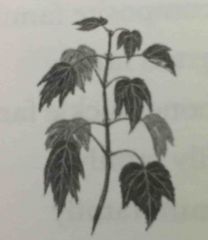![]()
![]()
![]()
Use LEFT and RIGHT arrow keys to navigate between flashcards;
Use UP and DOWN arrow keys to flip the card;
H to show hint;
A reads text to speech;
46 Cards in this Set
- Front
- Back
|
An underground structure made of thick,fleshy leaves surrounding a very short stem is a ____. |
bulb |
|
|
What is the scientific term for plants that produce covered, protected seeds? |
angiosperm |
|
|
What type of plant needs two growing seasons to complete its life cycle? |
biennial |
|
|
A fruit develops from the part of the flower called the ____. |
ovary |
|
|
Which part of the embryo develops into the root system? |
radicle |
|
|
A good scientific experiment will include____. |
several constant factors and one variable |
|
|
What does the term fauna describe? |
animals |
|
|
What is the sum of all body activities? |
metabolism |
|
|
What is the study of body structure? |
anatomy |
|
|
The purpose of science is ____. |
to discover the laws of creation and use them for man's benefit |
|

Label the leaf arrangement above. |
opposite |
|

Label the leaf arrangement above. |
alternate |
|

The type of margin illustrated by the leaf above is____. |
lobed |
|

The type of venation illustrated by the leaf above is____. |
pinnate |
|
|
includes meadow, desert, and mountain environments |
terrestrial |
|
|
active at night |
nocturnal |
|
|
the specific place within an environment where an organism lives |
habitat |
|
|
a water environment |
aquatic |
|
|
The term that refers to leaves that attach directly to a stem is ____. |
sessile |
|
|
Most grasses have a creeping stem called a ____ that grows along the surface of the ground. |
stolon |
|
|
A leaf that has more than one blade joined to the petiole is known as a ____ leaf. |
compound |
|
|
A seedling is a young plant that is able to survive without its ____. |
cotyledons |
|
|
seas and oceans |
marine |
|
|
living in trees |
arboreal
|
|
|
produces legumes |
pea family |
|
|
fruits called grains |
grass family |
|
|
square and stout stems |
mint family |
|
|
stems called corms and rhizomes |
amaryllis family |
|
|
flowers arranged in umbels |
parsley family |
|
|
helps return nitrogen to the soil |
pea family |
|
|
includes sunflowers |
composite family |
|
|
includes Queen Anne's lace |
parsley family |
|
|
List the six steps of the scientific method. |
1. State the problem. 2. Gather information about the problem. 3. Formulate a hypothesis. 4. Test the hypothesis by designing and performing an experiment. 5. Record and analyze any new changes during the experiment. 6. State the conclusions. |
|
|
Essay: Compare monocots and dicots. |
Monocots only have one cotyledon. They have long, slender leaves with parallel veins, three petals per group, and a fibrous root system. Dicots have two cotyledons. They have broad leaves with veins that branch out, four to five petals per group, and a taproot system. |
|
|
One of the three things required for germination |
any one of these: moisture temperature oxygen |
|
|
Two general methods of seed dispersal are ____ dispersal and ____ dispersal. |
mechanical and agent |
|
|
The Englishman who introduced the scientific method was ____. |
Sir Bacon Francis |
|
|
The term for any living thing is ____. |
organism |
|
|
The food making process of plants is called ____. |
photosynthesis |
|
|
Herbaceous plants have stems that are ____. |
non-woody |
|
|
The type of flowers usually found in the center of a composite flower head are _____. |
disk flowers |
|
|
The ____ carries water and nutrients from the root hairs upward through the root and stem to the leaves. |
xylem |
|
|
A sperm cell joining an egg cell is ____. |
fertilization |
|
|
A living thing with ____ can be cut in equal halves in more than one direction. |
radical symmetry |
|
|
A scientific idea that has survived many experiments and observations without being proven false is called a ____. |
law |
|

Label each specific part of the flower beside the corresponding number. |
37. stigma 38. style 39. ovary 40. anther 41. filament 42. stamen 43. pistil |

